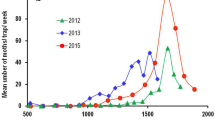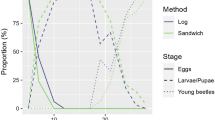Abstract
The diamondback moth, Plutella xylostella (L.), is a cosmopolitan pest of brassicaceous crops occurring in regions with highly distinct climate conditions. Several studies have investigated the relationship between temperature and P. xylostella development rate, providing degree-day models for populations from different geographical regions. However, there are no data available to date to demonstrate the suitability of such models to make reliable projections on the development time for this species in field conditions. In the present study, 19 models available in the literature were tested regarding their ability to accurately predict the development time of two cohorts of P. xylostella under field conditions. Only 11 out of the 19 models tested accurately predicted the development time for the first cohort of P. xylostella, but only seven for the second cohort. Five models correctly predicted the development time for both cohorts evaluated. Our data demonstrate that the accuracy of the models available for P. xylostella varies widely and therefore should be used with caution for pest management purposes.

Similar content being viewed by others
References
Ávila CJ, Milanez JM, Parra JRP (2002) Previsão de ocorrência de Diabrotica speciosa utilizando-se o modelo de graus dia de laboratório. Pesq Agrop Brasileira 37:427–432
Ayalew G, Ogol CKPO (2006) Occurrence of the diamondback moth (Plutella xylostella L.) and its parasitoids in Ethiopia: influence of geographical region and agronomic traits. J Appl Entomol 130:343–348
Borchert DM, Stinner RE, Walgenbach JF, Kennedy GC (2004) Oriental fruit moth (Lepidoptera: Tortricidae) phenology and management with methoxyfenozide in North Carolina apples. J Econ Entomol 97: 1353–1364
Butts RA, McEwen FL (1981) Seasonal populations of the diamondback moth, Plutella xylostella (Lepidoptera: Plutellidae), in relation to day-degree accumulation. Can Entomol 113:127–131
Campos WG, Schoereder LH, DeSouza OF (2006) Seasonality in neotropical populations of Plutella xylostella (Lepidoptera): resource availability and migration. Popul Ecol 48:151–158
Chang WXZ, Tabashnik BE, Artelt B, Malvar T, Ballester V, Ferre J, Roderick GK (1997) Mitochondrial DNA sequence variation among geographic strains of diamondback moth (Leipdoptera: Plutellidae). Ann Entomol Soc Am 90:590–595
Damos P, Savopoulou-Soltani M (2007) Flight patterns of Anarsia lineatella (Lepidoptera: Gelechiidae) in relation to degree-days heat accumulation in Northern Greece. Commun Agric Appl Biol Sci 72:465–468
Damos P, Savopoulou-Soltani M (2012) Temperature-driven models for insect development and vital thermal requirements. Psyche 2012:1–13
Davis PM, Brenes N, Allee LL (1996) Temperature dependent model to predict regional differences in corn rootworm (Coleoptera: Chrysomelidae) phenology. Environ Entomol 25:767–775
Elliott NC, Jackson JJ, Gustin RD (1990) Predicting western corn rootworm beetle (Coleoptera: Chrysomelidae) emergence from the soil using soil or air temperature. Can Entomol 122:1079–1091
Gilbert N, Raworth DA (1996) Insect and temperature, a general theory. Can Entomol 128:1–13
Golizadeh A, Kamali K, Fathipour Y, Abbasipour H (2007) Temperature-dependent development of diamondback moth, Plutella xylostella (Lepidoptera: Plutellidae) on two brassicaceous host plants. Insect Sci 14:309–316
Harcourt DG (1954) The biology and ecology of the diamondback moth, Plutella maculipennis Curtis, in eastern Ontario. Ph.D. Thesis, Cornell University, Ithaca, NY
Herms DA (2004) Using degree-days and plant phenology to predict pest activity. In: Krischik V, Davidson J (eds) IPM of midwest landscapes. University of Illinois, USA, pp 49–50
Honék A (1996) Geographical variation in thermal requirements for insect development. Eur J Entomol 93:303–312
Ikemoto T, Takai K (2000) A new linearized formula for the law of total effective temperature and the evaluation of line-fitting methods with both variables subject to error. Environ Entomol 29: 671–682
Kim DS, Boo KS, Jeong HY (2004) Evaluation of pheromone lure of Grapholita molesta (Lepidoptera: Tortricidae) and forecasting its physiological events in Suwon. Korean J Appl Entomol 43:281–289
Knutson AE, Muegge MA (2010) A degree-day model initiated by pheromone trap captures for managing pecan nut casebearer (Lepidoptera: Pyralidae) in pecans. J Econ Entomol 103:735–743
Lindblad M, Sigvald R (1996) A degree-day model for regional prediction of first occurrence of fruit flies in oats in Sweden. Crop Prot 6:559–565
Liu SS, Chen FZ, Zalucki MP (2002) Development and survival of the diamondback moth (Lepidoptera: Plutellidae) at constant and alternating temperatures. Environ Entomol 31:221–231
Logan JA, Wollkind DJ, Hoyt SC, Tanigoshi LK (1976) An analytic model for description of temperature dependent rate phenomena in arthropods. Environ Entomol 5:1133–1140
Marchioro CA, Foerster LA (2011) Development and survival of the diamondback moth, Plutella xylostella L. (Lepidoptera: Yponomeutidae) as a function of temperature: effect on the number of generations in tropical and subtropical regions. Neotrop Entomol 40:533–541
Marchioro CA, Foerster LA (2012) Modelling reproduction of Plutella xylostella L. (Lepidoptera: Plutellidae): climate change may modify pest incidence levels. Bull Entomol Res 102:489–496
Mohan M, Gujar GT (2003) Local variation in susceptibility of the diamondback moth, Plutella xylostella (Linnaeus) to insecticides and detoxification enzymes. Crop Prot 22:495–504
Mohan M, Sushil SN, Selvakumar G, Bhatt JC, Gujarb GT, Gupta HS (2009) Differential toxicity of Bacillus thuringiensis strains and their crystal toxins against high-altitude Himalayan populations of diamondback moth, Plutella xylostella L. Pest Manag Sci 65:27–33
Moore JL, Liang S, Akullian A, Remais JV (2012) Cautioning the use of degree-day models for climate change projections in the presence of parametric uncertainty. Ecol Appl 22:2237–2247
Nava DE, Parra JRP (2003) Biology of Cerotoma arcuatus (Coleoptera: Chrysomelidae) and field validation of a laboratory model for temperature requirements. J Econ Entomol 96:609–614
Pichon A, Arvanitakis L, Roux O, Kirk AA, Alauzet C, Bordat D, Legal L (2006) Genetic differentiation among various populations of the diamondback moth, Plutella xylostella (Lepidoptera: Yponomeutidae). Bull Entomol Res 96:137–144
Sarfraz M, Dosdall LM, Keddie BA (2006) Diamondback moth–host plant interactions: implications for pest management. Crop Prot 25:625–639
Sarnthoy O, Keinmeesuke P, Sinchaisri N, Nakasuji F (1989) Development and reproductive rate of the diamondback moth Plutella xylostella from Thailand. Appl Entomol Zool 24:202–208
Shirai Y (2000) Temperature tolerance of the diamondback moth, Plutella xylostella (Lepidoptera: Yponomeutidae) in tropical and temperate regions of Asia. Bull Entomol Res 90:357–364
Statsoft Inc (2008) Statistica for Windows: electronic manual. http://documentation.statsoft.com/. Accessed 18 Aug 2015
Talekar NS, Shelton AM (1993) Biology, ecology, and management of the diamondback moth. Annu Rev Entomol 38:275–301
Trudgill DL, Honek A, Li D, Van Straalen NM (2005) Thermal time—concepts and utility. Ann Appl Biol 146:1–14
Umeya K, Yamada H (1973) Threshold temperature and thermal constants for development of the diamondback moth, Plutella xylostella L., with reference to their local differences. Jpn J Appl Entomol Zool 17:19–24
Yamada H, Kawasaki K (1983) The effect of temperature and humidity on the development, fecundity and multiplication of the diamondback moth, Plutella xylostella (L.). Jpn J Appl Entomol Zool 27:17–21
Zou L, Stout MJ, Ring DR (2004) Degree-day models for emergence and development of the rice water weevil (Coleoptera: Curculionidae) in Southwestern Lousiana. Environ Entomol 33:1541–1548
Acknowledgments
The authors are grateful to the Brazilian National Research Council (CNPq) and Brazilian Federal Agency for Support and Evaluation of Graduate Education (CAPES) for the scholarships and financial support provided.
Author information
Authors and Affiliations
Corresponding author
Additional information
Edited by Wesley AC Godoy – ESALQ/USP
Rights and permissions
About this article
Cite this article
Marchioro, C.A., Krechemer, F.S., de Moraes, C.P. et al. Reliability of Degree-Day Models to Predict the Development Time of Plutella xylostella (L.) under Field Conditions. Neotrop Entomol 44, 574–579 (2015). https://doi.org/10.1007/s13744-015-0331-4
Received:
Accepted:
Published:
Issue Date:
DOI: https://doi.org/10.1007/s13744-015-0331-4




